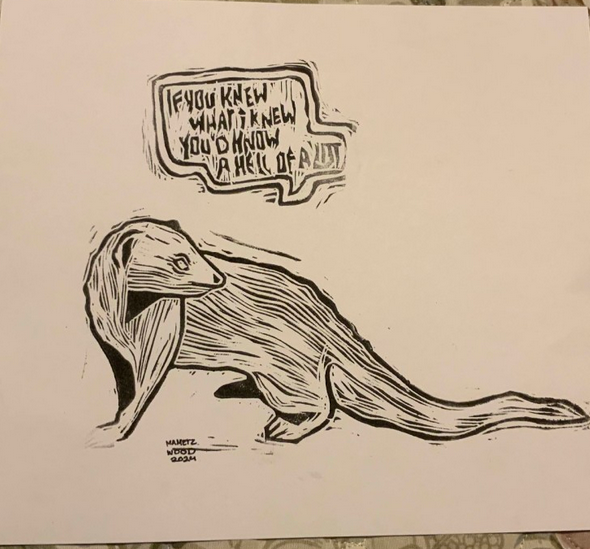I. “If you knew what I knew, you’d know a hell of a lot.”
Something happened in the Irving farmhouse.
Whether you believe it was teenage angst, a bid for attention by an unsatisfied sheep-farmer, a regular run-of-the-mill ghost or an incredibly talkative and extra clever mongoose, one thing about the affair remains clear: all was not as it should have been at Cashen’s Gap.
It has been nine decades since Gef (pronounced Jeff, with a soft G sound) made his first introductions to the Irving family, who were newcomers themselves to the Isle of Man.
There is little to be said of the pre-Gef chapter in the Irving family history, beyond the fact that Voirrey was the youngest of the Irving children by a large margin - information on her siblings is scarce but they were full-grown adults by the time she was born.
Mr Irving (Jim, to Gef - he was awfully familiar with the family, living in their walls) was what was then known as a ‘commercial traveller’ before the collapse of his business, wherein he decided to take up farming.
Whatever decision led him to choose the Isle of Man over anywhere else in the English countryside - the Isle is an insular Crown Dependency with its own customs, parliament, and laws - remains, as far as I can tell, a mystery.
Perhaps it was fate that brought the Irvings to Cashen’s Gap, or perhaps a desperate decision by a stressed father. Whatever it was, the Irvings had no idea what else lay in store for them beyond a lack of electricity or running water. After all, the rental advertisement had not, to my knowledge, mentioned any herpestidae on the property - conversational or otherwise.
II. "I have three spirits, and their names are Foe, Faith and Truth"
If there’s anything at all to be gleaned from horror films and paranormal literature (both fiction and non-fiction, although the second label is doing some heavy lifting there) it’s that teenage girls and weird phenomena are acutely intertwined.
Carrie White in Carrie, Eleven in Stranger Things, Reagan in The Exorcist - whatever it is about teenage girls, ghosts and ghouls love it. Gef was no different. That’s not to malign his reputation at all - I’m sure he was a morally upright mongoose - but his main fascination seemed to lie squarely with Voirrey Irving, the Irvings’ thirteen-year-old daughter.
In the 1930s there was no such thing as being a teenager. You were a child up until the moment you weren’t. That is to say - there was none of the help or understanding available to struggling adolescents that there is now. Our generation has the benefit of people understanding that the ages 13-18 are a uniquely difficult time, where hormones and stressors can send you spiraling over the simplest things.
Voirrey Irving was a thirteen-year-old city girl thrust into a farmhouse with no running water or electricity on an island completely culturally different to the mainland she was used to. Her old friends in Liverpool had no way to contact her beside the occasional letter (if the mail even reliably reached the island). Voirrey Irving was, to put it simply, a girl adrift.
I cannot stress enough to you, dear reader, that I am not calling Gef a hoax, or Voirrey crazy.
If Voirrey conjured Gef up herself, I firmly believe that she didn’t know it. Gef was ill-tempered, clingy, quick to anger. Voirrey was often the target of his love and his ire. Why invent something that hurts you so (according to Voirrey, the girls at school teased her endlessly for living in a haunted house) and why publicise it?
III. “He's damned well not going to get to know my inferior complex."
Belief in the paranormal was on the rise in the UK during the 1920s and 1930s. World War One had completely devastated the country. Entire villages of men had been wiped out¹. The public were desperate to know what lay in the Great Beyond. Grieving mothers paid psychics to let them say goodbye to their sons, lost out their on the French Battlefields. Ghost sightings rose. The nation was traumatised. The nation needed someone to make it all feel better.
Enter Harry Price.
For every believer, there is a non-believer. For every person making psychic phenomena their business, there’s… another person making psychic phenomena their business, but in the opposite direction.
It is important to bear in mind that Price was not a hard-line skeptic. He wanted to believe. He wanted there to be an afterlife, for the dead to be able to speak to the living. Price’s all-consuming passion, after all, was psychic phenomena. He just wanted to find something real.
His first major success was in debunking a ‘spirit photographer’ called William Hope. Not at all relevant to Gef, but still interesting, is the fact that from then on Arthur Conan Doyle (yes, the author of Sherlock Holmes) had it out for Harry Price. Sherlock Holmes may have been rational and reasonable but Conan Doyle? Apparently not.
After Hope came the debunking of the chewed-up-paper and cardboard ectoplasm of the sham medium Eva Carrière, then the false séance held by George Valiantine (wherein it was discovered that everything the subject of the séance, Italian composer Luigi Arditi, was saying was copied verbatim from a language phrasebook). By the late 1920s, Price was the leading man of the debunking-fake-ghosts movement.
It was no wonder, then, that Price found himself at Cashen’s Gap in July 1935. A talking mongoose - an extra extra clever talking mongoose, no less - would be the find of the century. Arthur Conan Doyle could take his fake mediums and stuff them.
I wish I could say that Gef ended Price’s career in debunking quackery. I wish I could say Price’s socks were rocked all the way off. I wish I could say all this, and have it be true. However, after his visit, Harry Price was not convinced. He commented in his book - The Haunting of Cashen's Gap - "As these Confessions go to press, Gef is still exchanging wisecracks with Irving; still dancing to the gramophone on top of his 'sanctum'; still screwing rabbits' necks for the Irving table; and, I am afraid, still impressing a number of rather credulous people."
As gentle as Price may have been in his book, and as non-comittal as he tried to sound, his answer was clear: there was no such thing as a talking mongoose, and he'd never seen one. The Irvings were subject to widespread discussion and mockery, something the shy teenage Voirrey absolutely despised.
The field of psychology was in its infancy in 1935. Sigmund Freud was still kicking around, and lobotomies were yet to come. Parapsychology, such as it was, amounted to men going to look at things and if nothing happened while they were standing there - well, that was their answer. The fact the person Gef’s life revolved around was a teenage girl did nothing to help the Irvings’ case.
There is no happy ending to this story, really. No satisfying conclusion. The Irvings left the island in 1937.
Nandor Fodor, a peer of Price's, wrote in an essay originally published in 1938 and reproduced in his 1952 book "Haunted People: The Story of the Poltergeist down the Centuries" "That the 'something' which is called Gef exists and talks, I hold proved, but as to what it is, opinions may differ. Once we step into the marvellous, reason and logic give us no bearings." He continued - "[...] "deliberate deception on the part of the whole family cannot be entertained as a solution of the mystery".
"The charge of ventriloquism is best answered by the fact that Gef has been heard when each member of the family has been alternately eliminated. It is sufficient to spend a day at Doarlish Cashen to know that, under their conditions of living, it would be impossible to carry on a ventriloquial imposition over a period of years".
Cashen’s Gap was taken over by a farmer named Leslie Graham, who claimed in 1947 that he had shot and killed Gef. Leslie Graham, like most British people in the 1940s, had presumably never seen an Indian Mongoose in the flesh before (alive or dead) because the corpse he produced was black-and-white**. Indian Mongooses are brown, with little pink noses. It was too big to be Gef, said Voirrey. She never spoke of him publicly of her own volition after that. It also is pretty hard to shoot a spirit, I think. What with all that “not being corporeal”.


In 1970 Voirrey was tracked down by a magazine on psychic phenomena called FATE. She was reluctant to speak about Gef but maintained that he was real, and wished that he wasn’t. She died in 2005, still holding to that.
Gef’s fate remains unknown. People still make the pilgrimage to where the Irving farmhouse once stood, hoping to coax him out of hiding. If he was still (un)alive he would be about 172 years old. Regular Indian Mongeese, not the extra extra clever kind, live up to 12 years in captivity. Wherever he is, whether it’s in the Great Beyond or someone else’s walls, I hope he knows what a stir he caused.

¹ Pals Battalions, groups of volunteer soldiers who came from the same local area, were a popular idea during the war. The main problem with that? You’re going to lose all the men from that area, all at once. The English government are not forward thinkers.
Further Reading:
BBC Radio 4 - The Curious Case of The Talking Mongoose
The Strange Story of Gef, The Isle of Man's Talking Mongoose
Gef! The Strange Tale of an Extra-Special Talking Mongoose
HarryPriceWebsite.co.uk -Dedicated to the life & work of Harry Price (1881-1948)